Book with Confidence: Enjoy peace of mind — your 20% deposit is fully refundable up to 60 days before departure. See terms & conditions.
Self-Guided Classic Split to Dubrovnik Bike Tour
Croatia’s Adriatic coast has over 78 scenic islands, several of which are home to UNESCO World Heritage Sites and historic monuments dating back to the Greek era.
This is a bike tour that enables you to explore the most gorgeous of these islands by both bike and ferry.
Ride through vineyards, olive groves, white sand beaches, and Roman ruins all you want. And when you've had your heart’s fill, hop onto a boat, cross over onto the next island, and repeat.
Visit Diocletian’s Palace in Split, built by the Roman emperor Diocletian in the 3rd century CE as a retreat for himself, ride through fields of lavender in the island of Hvar, and enjoy the finest Croatian wines on the island of Korčula.
Self-Guided
casual hotels
Split
Dubrovnik
moderate
47 km / 29 mi
6
Min. 2, Max. 12
Split Airport (SPU)
Dubrovnik Airport (DBV)
Highlights
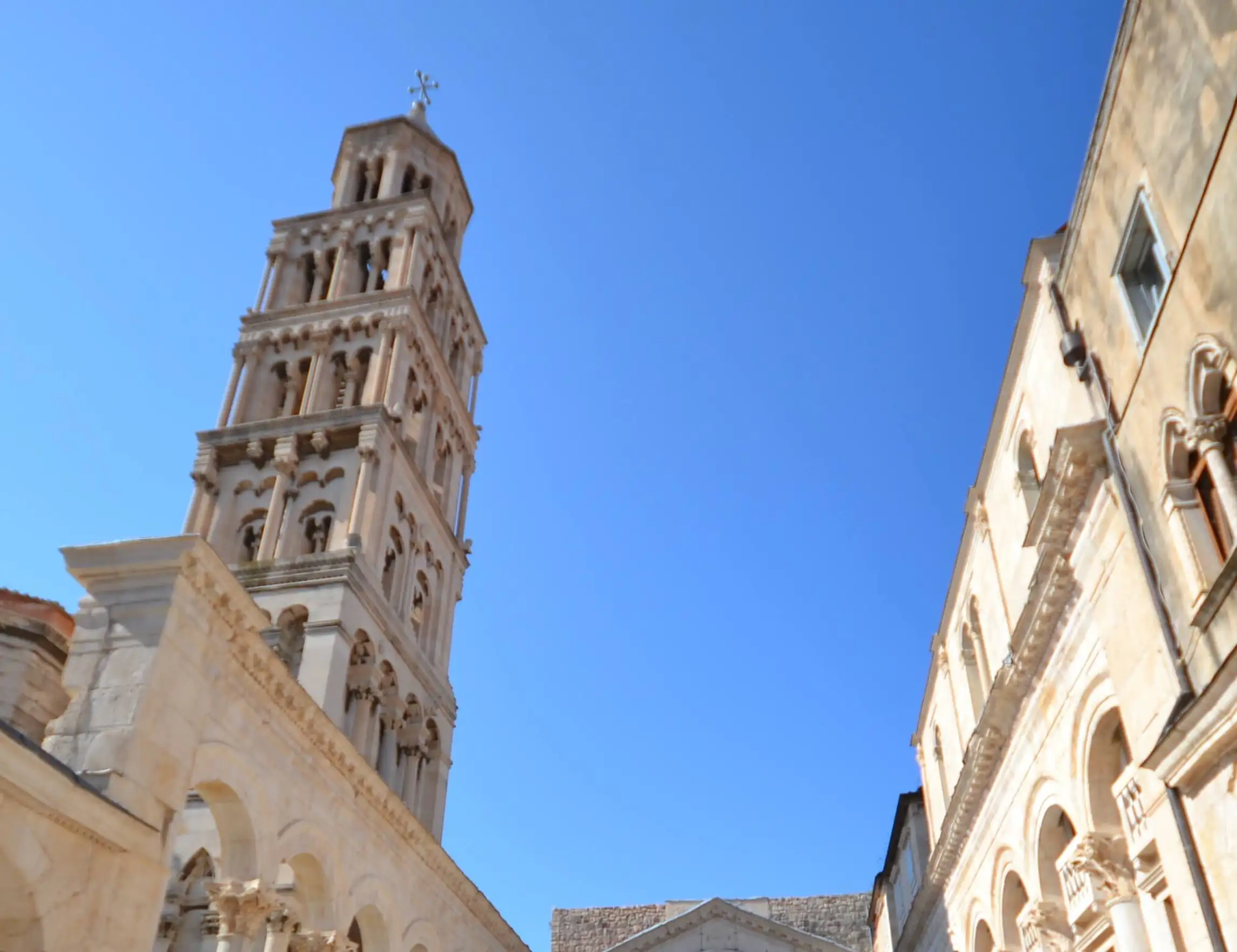
Diocletian’s Palace
Visit the 1700 Diocletian’s Palace in Split
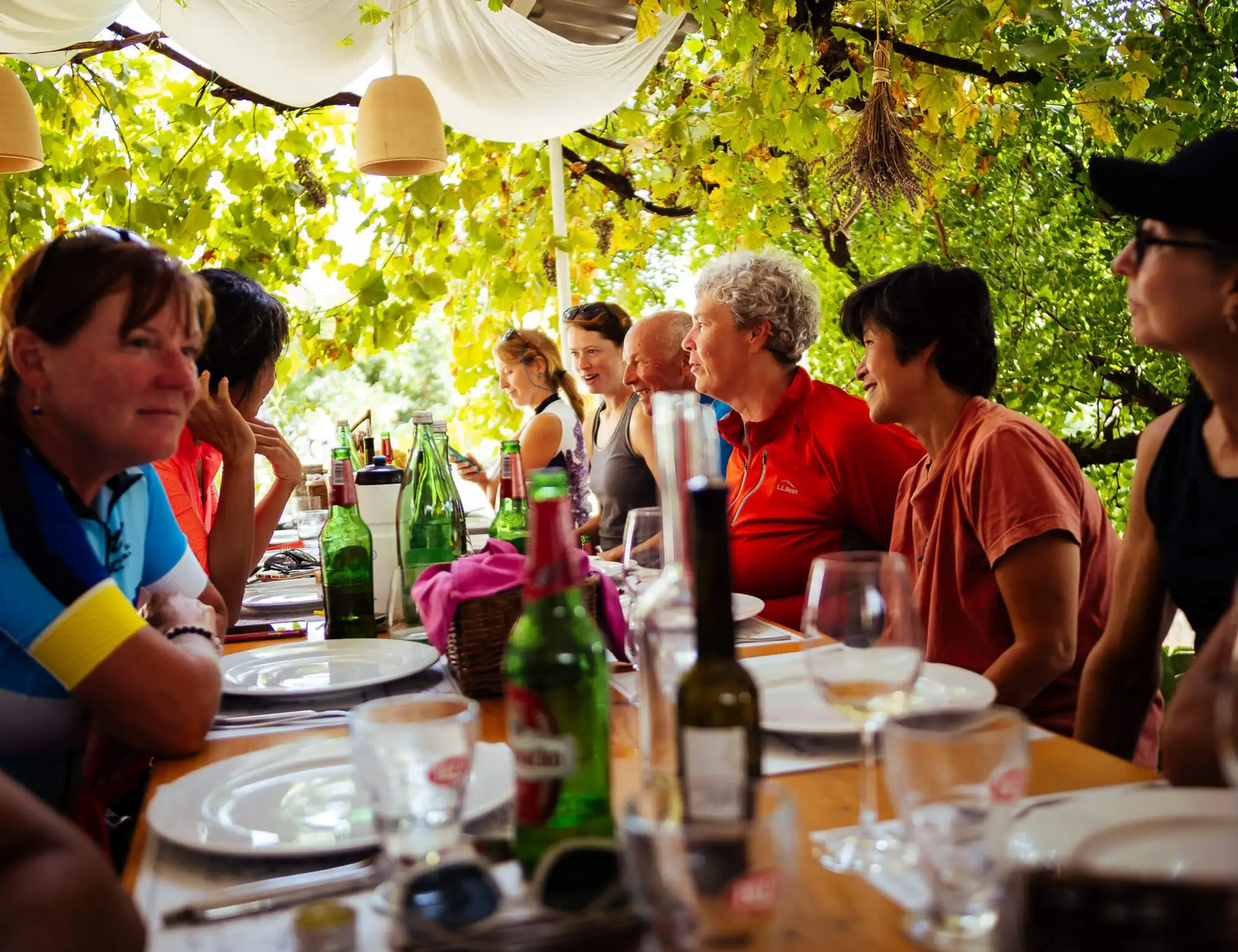
finest Croatian wines
Get to sample the finest Croatian wines including Peljesac and Dobricic
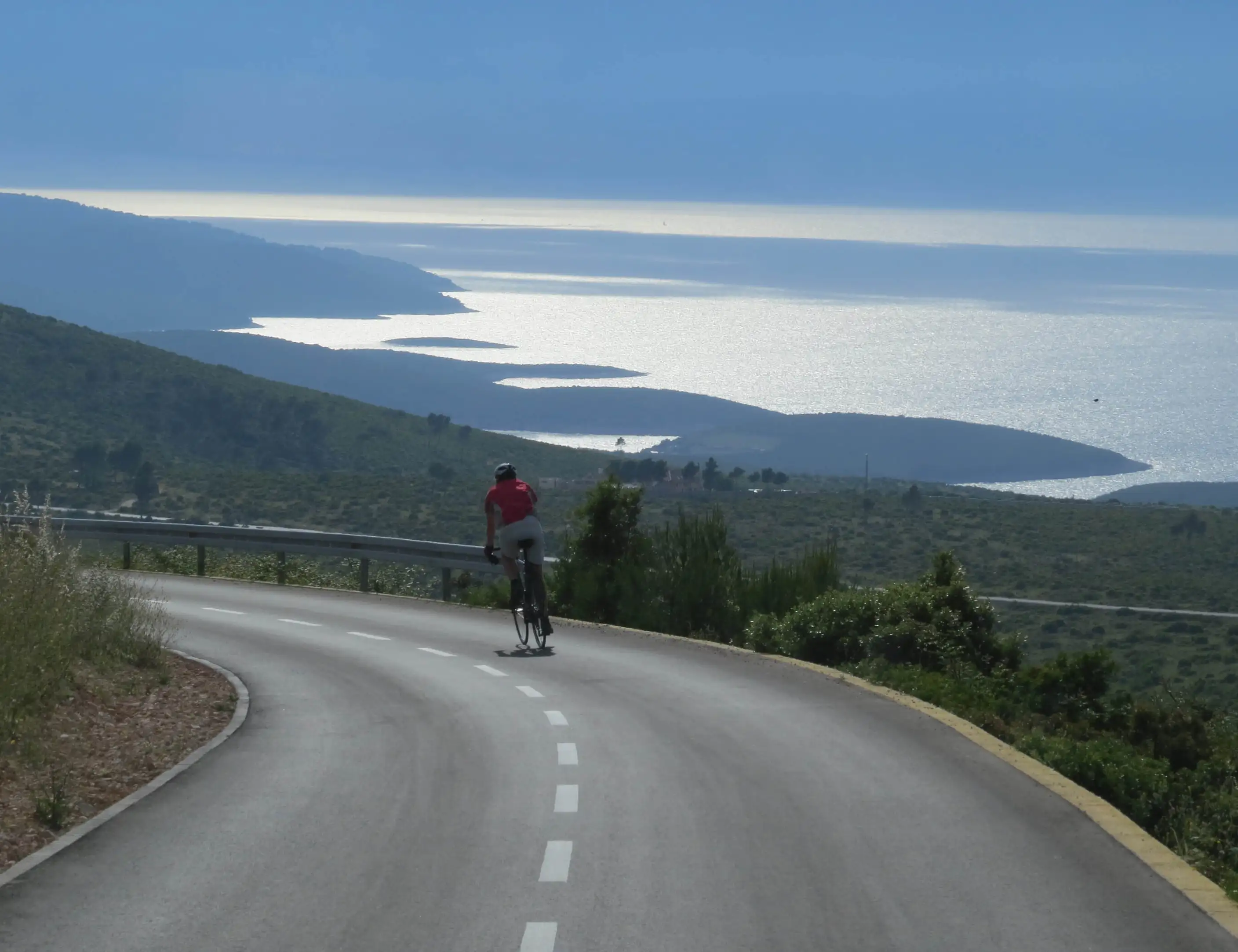
fields of lavender
Bike through fields of lavender in Hvar
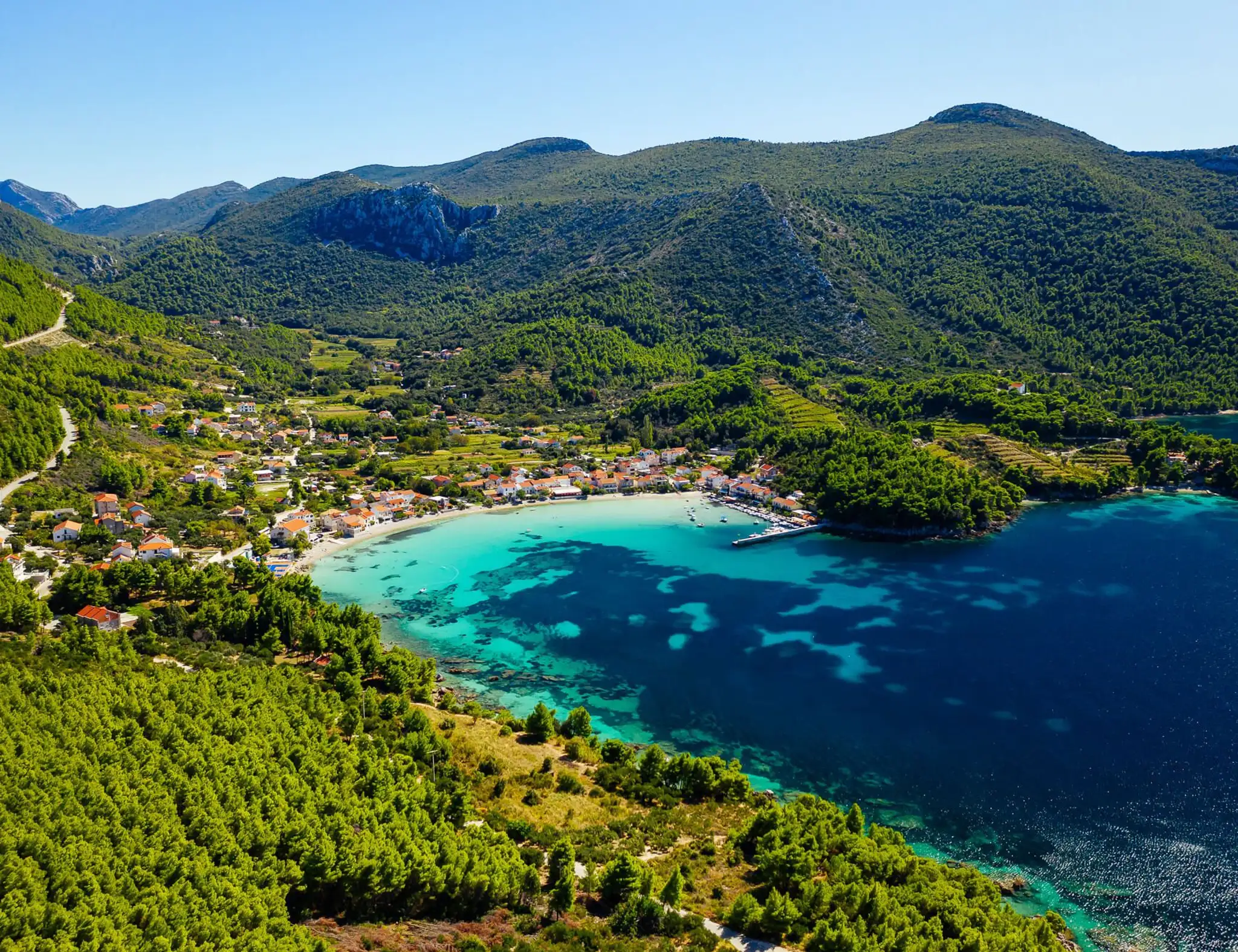
beautiful white sand beaches
Relax at some of the most beautiful white sand beaches in Europe
Itinerary
Brief Itinerary
Meals are indicated as B = Breakfast, L = Lunch, D = Dinner.
Listed hotels are subject to availability and may be replaced with similar alternatives of equal standard.
| Day | Place | casual Inns | Meals | Distance | Activity |
|---|---|---|---|---|---|
| DAY 1 | Split | Villa Baguc (4-star) | 17 km / 11 mi | cycling | |
| DAY 2 | Island of Hvar | Villa Nora Hvar | B | 60 km / 37 mi | cycling |
| DAY 3 | Island of Korčula | Marko Polo Hotel by Aminess (4-star) | B | 60 km / 37 mi | cycling |
| DAY 4 | Island of Korčula | Marko Polo Hotel by Aminess (4-star) | B | 45 km / 28 mi | cycling |
| DAY 5 | Ston | Hotel Ostrea | B | 50 km / 31 mi | cycling |
| DAY 6 | Konavle | Koraceva Kuca | B | 50 km / 31 mi | cycling |
| DAY 7 | Dubrovnik | Hotel Ivka | B | ||
| DAY 8 | Dubrovnik | B |
Detailed Itinerary
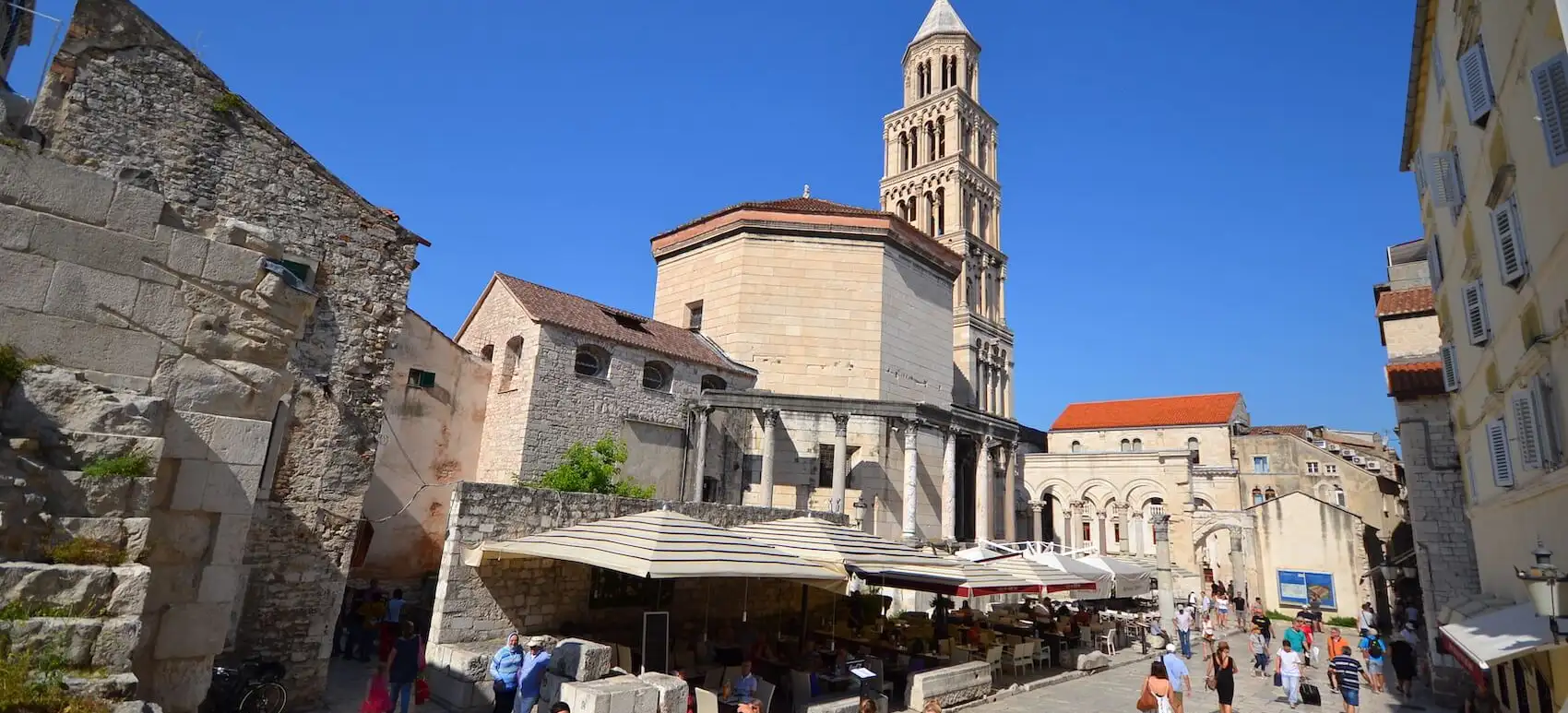
Day 1: Split
Our tour begins in the historic city of Split in southern Croatia. Split is the second largest city in Croatia after Zagreb and is well connected by air and sea to major European destinations. We meet at our hotel for introductions and bike fitting and you can then head out for a short bike ride along Split’s beautiful Adriatic coast, climbing to the top of the 178m high Marjan hill. The hill is a landmark of the city and is covered in dense pine forests. From its top, it offers breathtaking views of the Adriatic sea on the one hand and the city of Split on the other hand.
With the day’s biking done, head out on a city tour. Founded more than 2000 years ago as a Greek colony, Split’s city center is recognized as a UNESCO World Heritage site. The highlight of the day is a visit to the 1700-year-old Diocletian’s Palace. Built in the 4th century CE by the Roman emperor Diocletian, the palace was a small fortress that housed an entire military garrison. It is recognized today as a UNESCO World Heritage site.
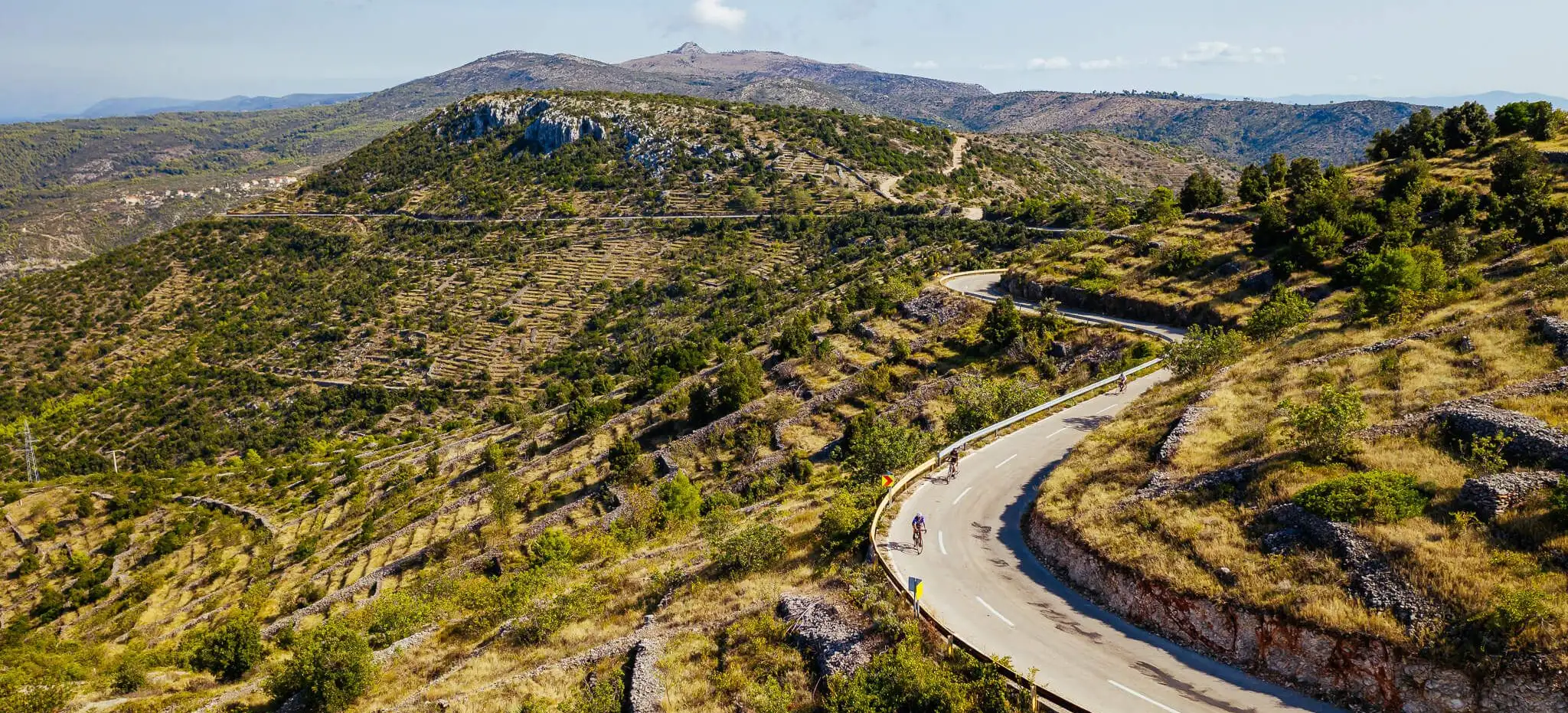
Day 2: Island of Hvar
Today sail off across the Adriatic to bike on the world-famous island of Hvar. Hvar is known for many things, but perhaps what it is known for the most is its field-upon field of lavender that comes alive in spring and early summer, painting the entire countryside a mesmerizing shade of purple. Stop to admire Stari Grad, a Greek village dating back to 400 BC and a UNESCO World Heritage site, before continuing on with the day’s biking through olive groves and vineyards.
Elevation gain: 950 m
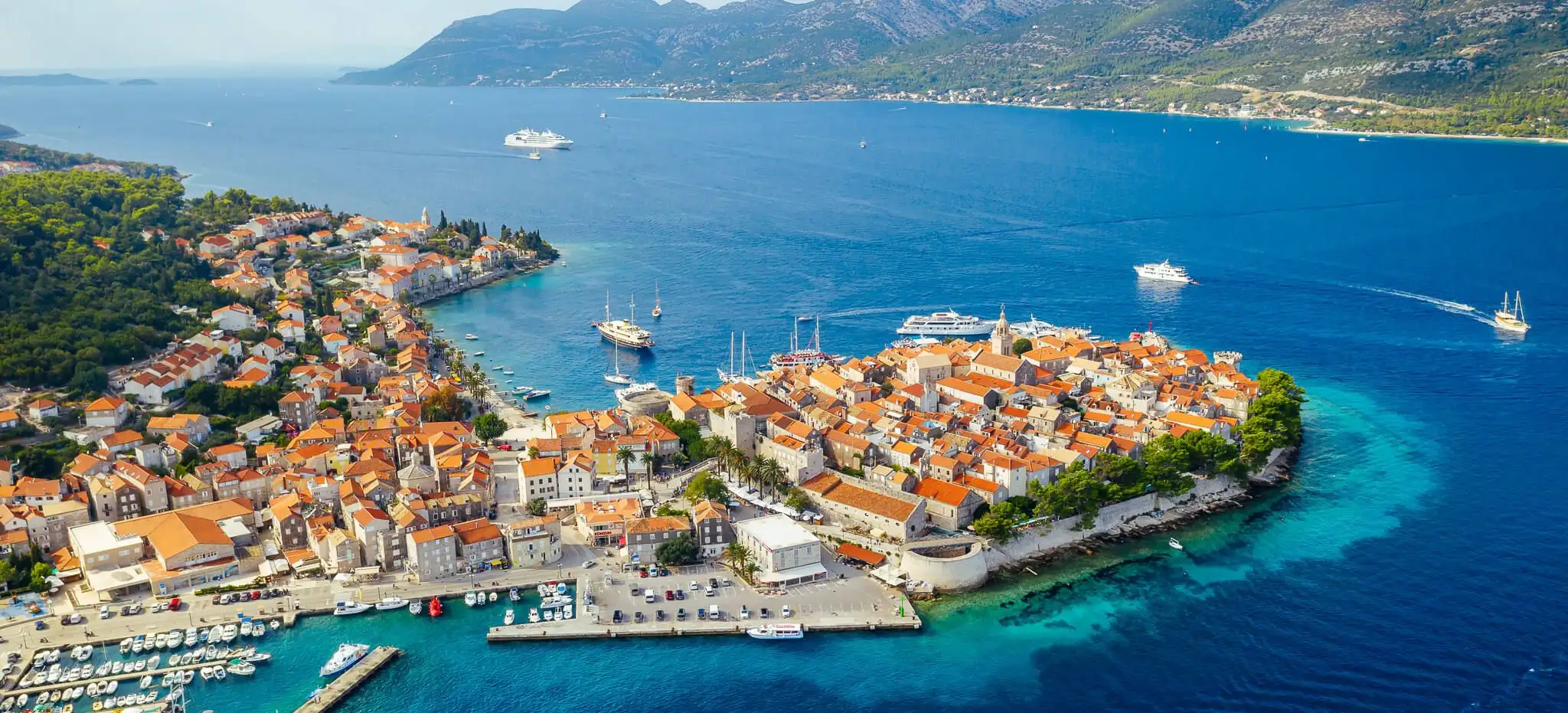
Day 3: Island of Korčula
Continue island-hopping on the Adriatic as you board the ferry this morning and sail along with bikes to the lesser-known island of Korcula. The island is covered with thick forests of holm oak and pine that the Greeks used for building ships. It has excellent white sand beaches and great views of the clear blue waters of the Adriatic. But above all, Korcula is known for the excellent white wines it produces, three of which, namely, Posip, Rukatac, and Grk are especially noted among wine lovers. Stop by a small village and have a traditional Mediterranean lunch with a local family before heading to your hotel.
Elevation gain: 820 m
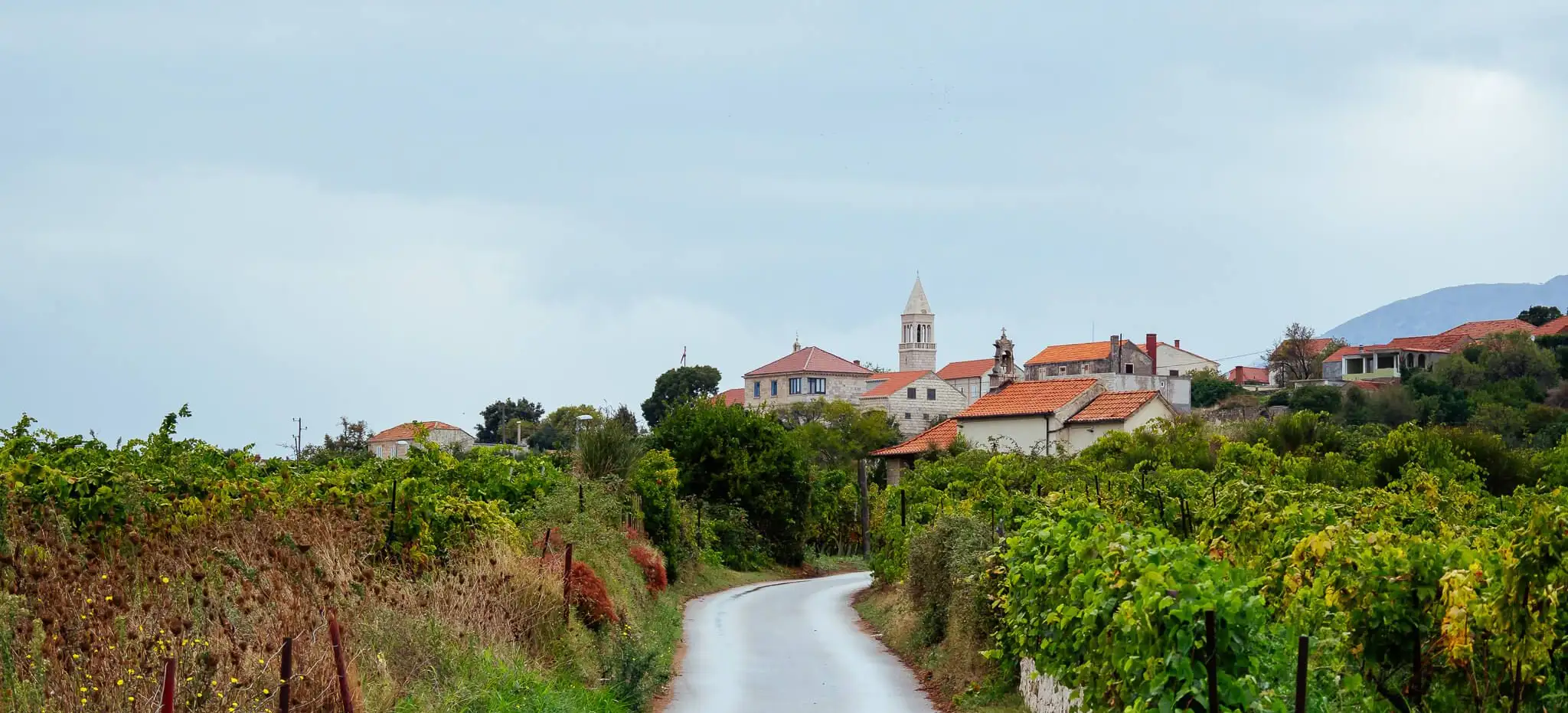
Day 4: Island of Korčula
While you extend your stay in Korcula, seize the opportunity to explore its hidden coves, picturesque old towns, charming small villages, and dense pine forests that blanket the island. Today offers several loop options, each leading you through vineyards, olive groves, and the stunning coastline. Indulge in traditional dishes like homemade gnocchi, macaroni, pasticada, and other culinary delights passed down through generations of locals. Don't miss the chance to savor some of Croatia's finest white wines produced on this island, enhancing the flavors of your lunch or dinner. And let's not forget, Korcula boasts being the birthplace of Marco Polo, where his legendary journey began!
Day 5: Ston
Begin the day with a short ferry ride to the peninsula of Peljesac. Peljesac is famous for producing Croatia’s finest wine — the Peljesac wine. A hilly island dotted with vineyards, Peljesac is also known for producing great oysters and mussels. As you bike through the beautiful countryside, stop at a quaint village called Ston, famous for having the longest fortified wall in Europe built back in the 14th century.
Elevation gain: 550m
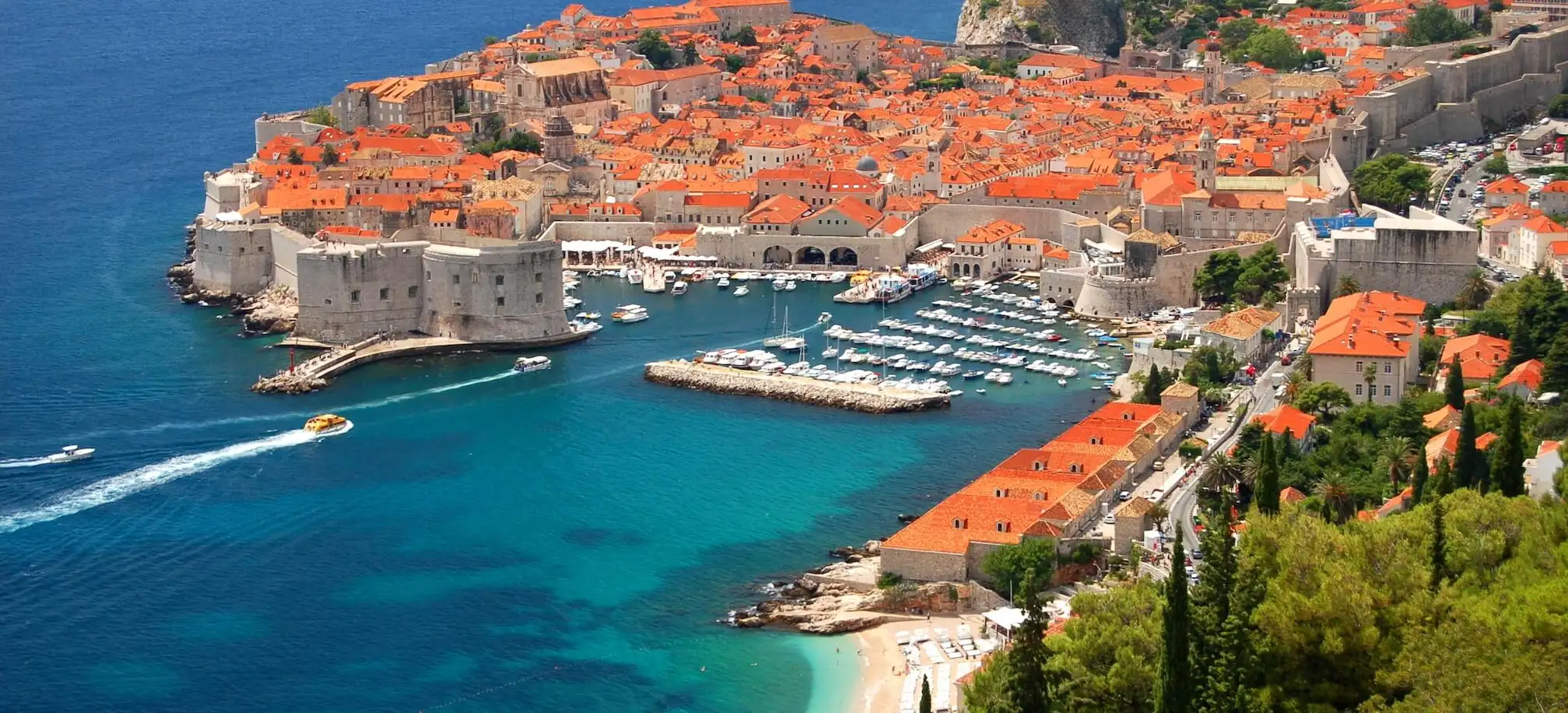
Day 6: Konavle
This morning, a short transfer brings you to Konavle, a tranquil valley tucked between the mountains and the Adriatic Sea, with vineyards, olive groves, and timeless stone hamlets. Begin your ride along the gentle Ljuta River, following quiet country lanes past centuries-old watermills and traditional farms that still echo with rural life. Stop to taste local wines or olive oils, or simply enjoy the serenity of this fertile valley.
For a more challenging option, continue toward the coast on a spectacular route that winds through hilltop villages and offers sweeping sea views all the way to the Montenegro border, passing the Ljuta River springs, Sokol Fortress, and the Franciscan Monastery.
Elevation: +400m
Longer route: +1073m over 65kms of riding
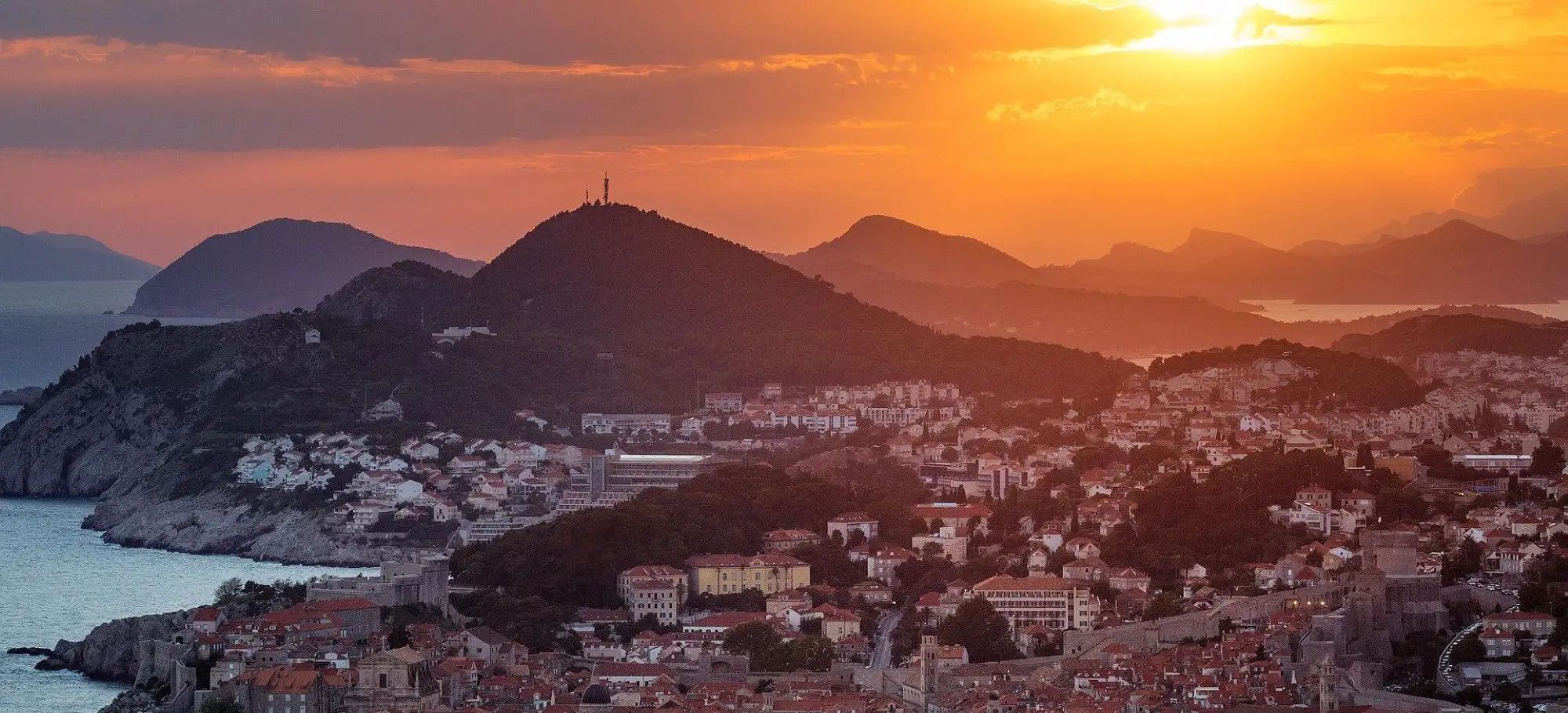
Day 7: Dubrovnik
A morning transfer takes you to Dubrovnik, Croatia’s most celebrated city. Enjoy a guided walking tour through the magnificent Old Town or explore at your own pace. Stroll along the ancient city walls, visit the elegant Rector’s Palace, and wander the narrow limestone streets lined with cafés, markets, and centuries of history. Discover landmarks such as the Stradun promenade, Fort Lovrijenac, and the nearby island of Lokrum.

Day 8: Dubrovnik
Travel further as per your onward travel plans. We will provide group transfer to Dubrovnik airport.
Ready to plan your adventure? Download a print-ready detailed itinerary.
Map
Dates and Prices
Book with Confidence: Enjoy peace of mind — your 20% deposit is fully refundable up to 60 days before departure. See terms & conditions.
Single Supplement
From US $720
E-Bike Upgrade
From US $140
Couldn't find a trip with convenient dates?
Open your date as a join-in tour or customize further as a private one.
Essential Info
Inclusions
LODGING
All hotels as mentioned in the tour details or similar (subject to availability).
bike
Immaculately maintained bike with helmet, suited to a terrain.
Luggage Transfer
Transportation of luggage from one hotel to another.
Airport drop
Enjoy a hassle-free group airport drop to finish your journey. Available only on the tour end date.
meals
Meals as per itinerary. Guests are given the opportunity to dine on their own so that they discover a location independently.
Additional Inclusions
- Assistance: bike fitting, detailed briefing with description of places you will be visiting en route, lunch options and marked map with options for shorter or longer routes
- Private water taxi shuttle between islands: Hvar – Korcula
- Ferry tickets Korcula island – Mljet island – Korcula island
- Day 6 transfer from Ston (Peljesac) to your accommodation in Dubrovnik
- Day 8 transfer to the Dubrovnik airport
- 24/7 emergency number
Exclusions
Airport pickup
We recommend to book direclty from airport.
Beverages
Beverages such as alcohol, tea, coffee, juice at a hotel or restaurant.
Gratuity
Gratuities for your guide team are not included in the trip price.
Bikes
A great ride begins with a great bike. Our tours typically include the models listed below, though in some cases—due to height or availability constraints—we may provide an equivalent alternative.
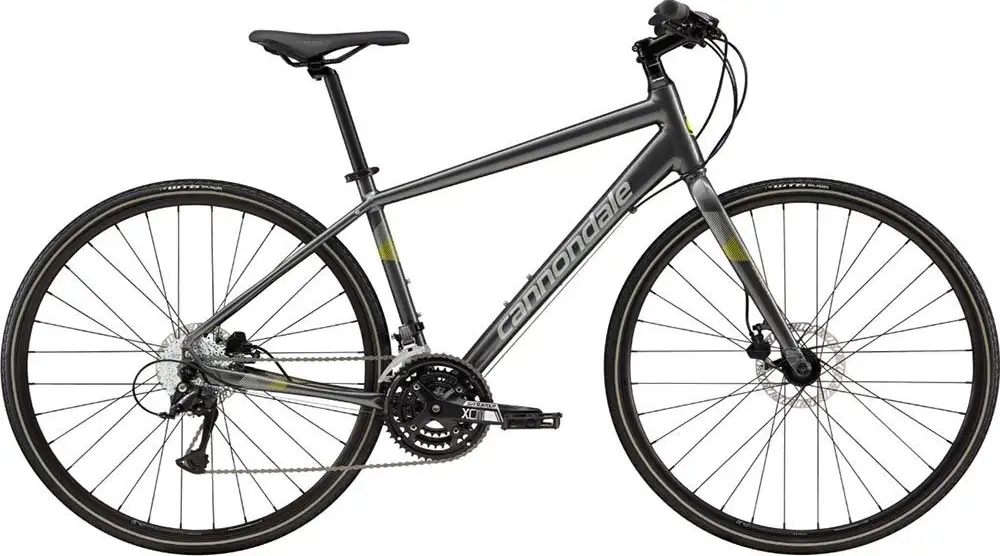
Cannondale Quick 5 or similar
Included in your trip price
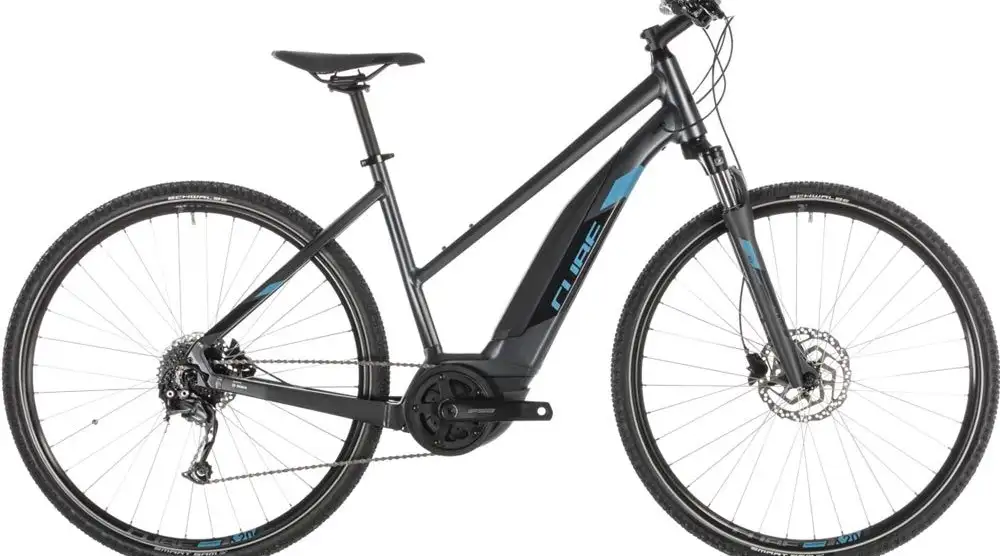
Cube Cross Hybrid One 400 or similar
Available at a surcharge
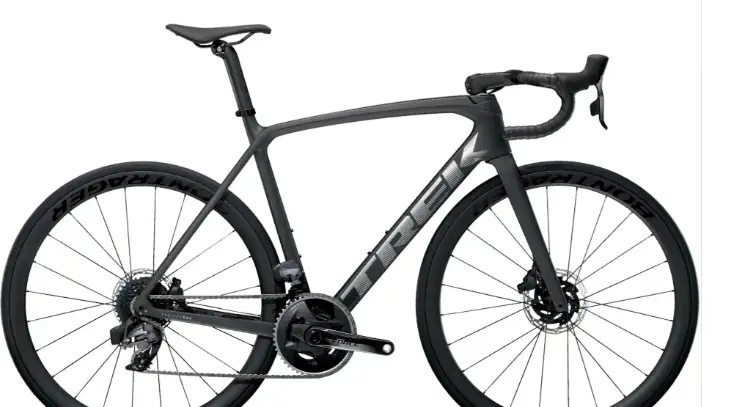
Trek Emonda Carbon Frame or similar
Available at a surcharge
What to Expect
We want you to have a fantastic experience on your tour, so we aim to be upfront about what to expect along the way. Here are key details to keep in mind:
A self-guided bike tour offers the freedom to explore at your own pace, but it also requires some preparation. To ensure a smooth and enjoyable journey, here’s what you can expect:
Basic Bike Maintenance: While we provide well-maintained bikes, you’ll need to handle minor repairs, such as fixing a flat tire or adjusting the brakes. We suggest learning basic repair skills and carrying tools like a multi-tool.
Navigation: You’ll be in charge of navigating the route using provided maps, route notes, or GPS. Confidence in following directions is key, and it's important to be able to correct your path if you stray from the route.
Route Difficulty & Fitness: Our tours cater to various fitness levels, but it’s important to choose a route that matches your ability. Be ready for the distances and terrain outlined in your itinerary.
Safety First: Wearing a helmet is essential, and obeying local traffic rules is crucial. Stay aware of your surroundings, especially in new or remote areas.
Luggage Transfers: We take care of transporting your luggage from one accommodation to the next, so you can focus on the ride. Simply drop off your bags at the designated time each morning, and they’ll be waiting for you at your next stop.
On Traffic Along the Way
Split to Dubrovnik is a beautiful cycling route and popular among cyclists. Cyclists can expect some motor traffic when entering and exiting major towns along the way such as Split, Ston, Korcula, and Dubrovnik, especially during the peak season.
Arrival & Departure Details
Arrival
Your tour begins in Split, Croatia's second-largest city. Split Airport (Zračna luka Split), also called Resnik Airport, is the main international gateway. It’s about 25 km (15 miles) west of Split city center, near Trogir. It is connected by air to major European destinations.
From the airport, you can either take an airport or a taxi to arrive at your hotel.
Departure
Your tour ends at Dubrovnik. A group transfer to the airport is included.
Weather
The best period for biking in Croatia is late spring (end of April till the end of June) and early autumn (end of August till the end of October). In the period mentioned it is not extremely hot, there is not too much traffic, and if you did not pre-book accommodation you can find it almost anywhere as it is not the main tourist season. It can happen if you have a couple of days of rain (rain showers). Summer temperatures vary from 22°C to 26°C in the continental part of the country, 15°C to 20°C in mountain regions, and 26°C to 30°C in the coastal region. The highest tourist season is from mid-July to mid-August, and usually not so easy to find accommodation (if not pre-booked).
Late November is not recommended for biking in Croatia as many hotels and restaurants are closed and weather is very unpredictable.
January
Offseason
February
Offseason
March
Offseason
April
Mixed
May
Good
June
Best
July
Mixed
August
Mixed
September
Best
October
Good
November
Mixed
December
Offseason
Best
Good
Mixed
Offseason
What to Pack
Packing smart is essential for a safe and enjoyable cycling adventure. From essential biking gear to clothing and travel necessities, this guide ensures you're prepared for any terrain or climate.
Recommended Bicycling Clothes & Gear
- Bicycling shoes or stiff-soled sneakers.
- Padded cycling shorts.
- Short-fingered cycling gloves (personal gloves are ideal).
- Brightly colored cycling jerseys or synthetic T-shirts for visibility.
- Synthetic cycling socks.
- Sunglasses with UV protection.
- Personal helmet (recommended even though provided).
- Personal saddle (optional for added comfort).
- Rain jacket or windbreaker.
- Cycling water bottle (to reduce plastic waste).
Note: Helmets, gloves, and water bottles are personal items, so bringing your own is recommended for maximum comfort and hygiene.
Clothing
- Light, breathable fabrics like cotton or linen.
- Full-sleeved clothing for sun protection.
- Warm layers for chilly mornings and evenings (if traveling in winter).
- Comfortable footwear for non-cycling time.
- Bring a compact rain jacket in case of sudden weather changes.
- Ethnic or modest clothing for exploring towns and temples.
Other Necessities
- Toiletries: Basic hygiene essentials, including insect/mosquito repellent and sunscreen.
- Hand sanitizer and wet wipes.
- Plug socket adaptor.
- Binoculars for wildlife spotting or desert landscapes.
Pro Tips
- Pack light but plan for the varying temperatures: warm days, chilly evenings, and desert winds.
- Use brightly colored clothing for visibility on roads.
- Pack light to leave room for shopping.
Luggage
Please limit your luggage to one medium-sized suitcase and one carry-on bag. Mark your luggage with your name, address, and phone number.
Visa Information
Before venturing on your adventure, make sure you're equipped with essential travel advice, including security updates, local laws, and crucial passport and visa information. Start by visiting the official government website of your home country for accurate and reliable guidance:
- UK Residents: Stay informed by reviewing the Foreign, Commonwealth & Development Office (FCDO) Travel Advice.
- US Residents: Access vital travel tips and updates through the US Department of State Travel Advice.
- Australian Residents: Plan ahead with the latest updates on the Smart Traveller website.
- Canadian Residents: Find comprehensive travel and visa guidance on the Government of Canada's Travel Advice and Advisories.
- New Zealand Residents: Get practical travel advice on the New Zealand SafeTravel website
- Residents of Other Countries: Check with your government or local consulate for tailored travel advice and requirements.
Note: Passport and visa regulations can change at any time. Stay proactive by checking for the latest updates to ensure a smooth and stress-free journey.
Insurance
Medical insurance that covers medical costs in case of an accident during the trip is mandatory to participate in our tours.
We recommend to purchase adequate travel insurance in order to participate in our tours and protect yourself from unforeseen events. Our experience shows that guests who purchase travel insurance—including coverage for all activities on the itinerary, trip cancellation, interruption, delay, baggage damage, loss or theft, personal accident, death and repatriation costs, medical and emergency expenses (including Covid-19), and personal liability—travel with greater peace of mind.
Can I use my credit card insurance?
Yes, as long as it meets our requirements and provides adequate coverage. Ensure you have an emergency contact number and policy number available.
When should I buy travel insurance?
Purchase travel insurance as soon as you've paid in full or booked your flights.
Is proof of travel insurance required?
Yes. You must provide your insurer's name, policy number, and emergency contact via our reservation form. This is mandatory. If you cannot provide proof, you’ll need to purchase insurance before traveling with us.
Does Art of Bicycle Trips sell travel insurance?
We do not sell travel insurance directly, as we believe our customers should have the freedom to choose a policy that best suits their needs. However, we recommend Insured Nomads as a great starting point.
Frequently Asked Questions
This tour is on largely paved surface.
Yes, on Day 1, one of our local representatives will meet you at your hotel at a pre-arranged time. You’ll receive a comprehensive tour briefing, where we’ll walk you through the itinerary day by day, explain how luggage transfers, ferry tickets, and other logistics will work, and answer any questions you may have.
Following the briefing, we’ll proceed with your bike fitting to ensure comfort and safety. After that, you’ll have the chance to go on a short, warm-up ride around Split, giving you time to get familiar with your bike and ease into the experience.
Yes, during ferry transfers, guests are required to carry their own luggage onto the ferry. Our team will take care of everything up to the ferry terminal and will collect your luggage on arrival at the next island, ensuring it is transferred safely to your hotel.
A self-guided bike tour allows you to explore independently using our detailed app-based navigation and pre-arranged logistics. We provide route notes via app, luggage transfers, hotel bookings, and emergency phone support. There is no local guide riding with you, so you manage your own navigation and basic bike upkeep.
For self-guided tours, the fitting process is designed to be simple and flexible while ensuring you start with a bike that suits your measurements.
Before Your Tour
When you book, we ask for your height. This allows our local partners to select the correct frame size and prepare the bike in advance so it’s close to your ideal fit when you arrive.
At the Start of the Tour
The setup experience varies by destination:
-
In some locations, you may receive an in-person handover with basic adjustments made by the local partner.
-
In others, especially in more remote regions, you may receive a bike that is pre-set based on the measurements you provided.
All self-guided bikes include basic tools, so you can make simple adjustments such as raising or lowering the saddle yourself.
During the Tour
You can adjust the bike as you ride using the provided tools. If anything feels off and you need assistance, our local partners are reachable and will support you as promptly as the location allows.
What to Expect
The self-guided bike fit is practical and rider-adjustable. It ensures:
- You start with the correct frame size
- You can fine-tune your comfort easily
- You have the flexibility to adjust as needed along the route
It’s not an in-depth professional fitting, but it’s perfectly suited for multi-day touring comfort.
We provide an app-based navigation system that includes all your daily routes, points of interest, and important trip notes. You can download the app to your phone in advance, and we’ll share your login details before your trip.
Yes. Once the routes are downloaded, the app works completely offline, so you don’t need mobile data while riding. You can even use it in airplane mode, which helps conserve your phone’s battery.
To extend battery life further, we recommend reducing screen brightness and carrying a small power bank for longer days on the trail.
A mobile holder is not provided. Since you’ll be using your phone for navigation, we strongly recommend bringing your own sturdy, handlebar-mounted mobile holder to ensure a safe and comfortable riding experience.
We do not provide GPX files separately. All routes are available within our navigation app, which is the most reliable and up-to-date source for your trip. Once you receive the login details for the navigation app — generally shared about one month before your departure — you can explore the routes and, if needed, also download the GPX files directly from the app for use with your personal Garmin or GPS device. We recommend getting familiar with the app and its features before your tour starts to ensure a smooth experience on the road.
For minor issues like punctures, the guests are provided with a self-repair kit, which includes tools to help them fix such minor issues. The exact contents of the kit depend on the type of bike, terrain and other factors, and will be communicated to you closer to your date of departure. However, usually such a kit includes tire levers, a spare tube, a patch kit, and a pump, allowing riders to fix the problem themselves. In some cases, the kit may only include a pump or a repair foam.
Self-guided riders are expected to be independent in handling these minor problems. While there are some bike shops along the route, they are limited. If you are unsure about how to repair a puncture, we recommend considering a guided or van-supported trip instead.
For major mechanical failures, such as a cable break, the guests can contact the emergency support number provided. The support team will help coordinate a solution, which could include dispatching a local mechanic, suggesting a nearby bicycle shop for repairs, or sending a vehicle to pick up the rider. Please note that all support services will be provided on a chargeable basis, and assistance may take time, so we advise being prepared for potential delays.
Yes, each rider will be provided with at least one pannier to carry personal items during the tour. Please note, road bikes do not support panniers.
Yes, we provide helmets. However, we recommend that guests try to bring their own helmets, as these are items of a personal nature.
Your luggage will be picked up at the reception of your hotel every morning by 9.00am.
It will be delivered to the next hotel before 5pm. Most of the time it is delivered in the early afternoon itself.
We recommend that you carry no more than 2 bags together weighing up to 15kgs for this trip. You can have one large bag, which contains all your clothing and gear needed for the trip, and one small bag that contains essential items you will frequently need such as passport etc. Please note that once a bag gets loaded in the luggage transfer vehicle, you may not have access to it till later in the evening when you reach the hotel for the night.
We provide local support by phone for any medical emergencies during the tour. Our local team will assist in coordinating medical care, guiding you to the nearest healthcare facility, and ensuring you receive the necessary support. The national emergency system is reliable and effective, and in the event of a serious accident, contacting them is highly recommended. However, due to our distance from certain areas, response times may be longer. We strongly recommend having appropriate travel insurance, and we will do everything we can to ensure your safety and well-being during an emergency.
Airport transfers are not included unless specifically mentioned in your trip inclusions.
For airport pickup, we recommend booking directly from the airport upon arrival — most airports have reliable taxi, shuttle, or app-based options.
For airport drop, please book a transfer through your last hotel — they can easily arrange it for you.
We focus on delivering exceptional experiences during your tour. For logistical simplicity and flexibility, we do not handle pre- or post-tour hotel bookings. However, we’re happy to share a list of recommended hotels near the starting and ending points of your trip so you can plan your stay independently.
We are happy to pass on your room preference for a twin or double setup, and our hotel partners do their best to accommodate these requests. However, room configurations are always subject to availability at each property.
On some of our trips—especially those that travel through remote regions or small boutique inns—room types may be limited. In such cases, despite our best efforts, you may need to stay in a double room instead of a twin, or twin instead of a double, depending on what is available.
Given the nature of our journeys and the unique places we visit, we kindly ask for your understanding and support if such adjustments are required.
We will always inform you in advance wherever possible and work closely with our partners to ensure the most comfortable arrangement for your stay.
The fitness level required for each trip is indicated by the "level" of the tour, which in turn is mentioned on each tour page right next to the price and the trip duration.
Easy: The terrain is mostly flat with a few gentle climbs.
Moderate: The terrain is either mostly flat or consists of rolling hills with a few challenging climbs. There could also be a few days with longer riding distances of up to 75 kms (45 miles)
Difficult: The terrain is mostly hilly with strong elevation gains and/or has long days on the bike. Such trips are recommended for intermediate to advanced cyclists.
Please note that we usually bike around 4-5 hours per day irrespective of the level of the trip.
You can exchange currency at the airport itself, or at ATMs in larger cities. Most commercial establishments will accept international credit cards for payments, though its good to carry some local currency with you at all times.
The meeting time on Day 1 is mentioned in your travel planner shared with you. You can arrive either on the morning of Day 1 depending on the meeting time, or book a pre-tour night to arrive a day earlier.
Reviews from our friends
You may also like

Popular
Self-Guided Classic Dubrovnik to Split Bike Tour
8 daysfrom$2,495/person
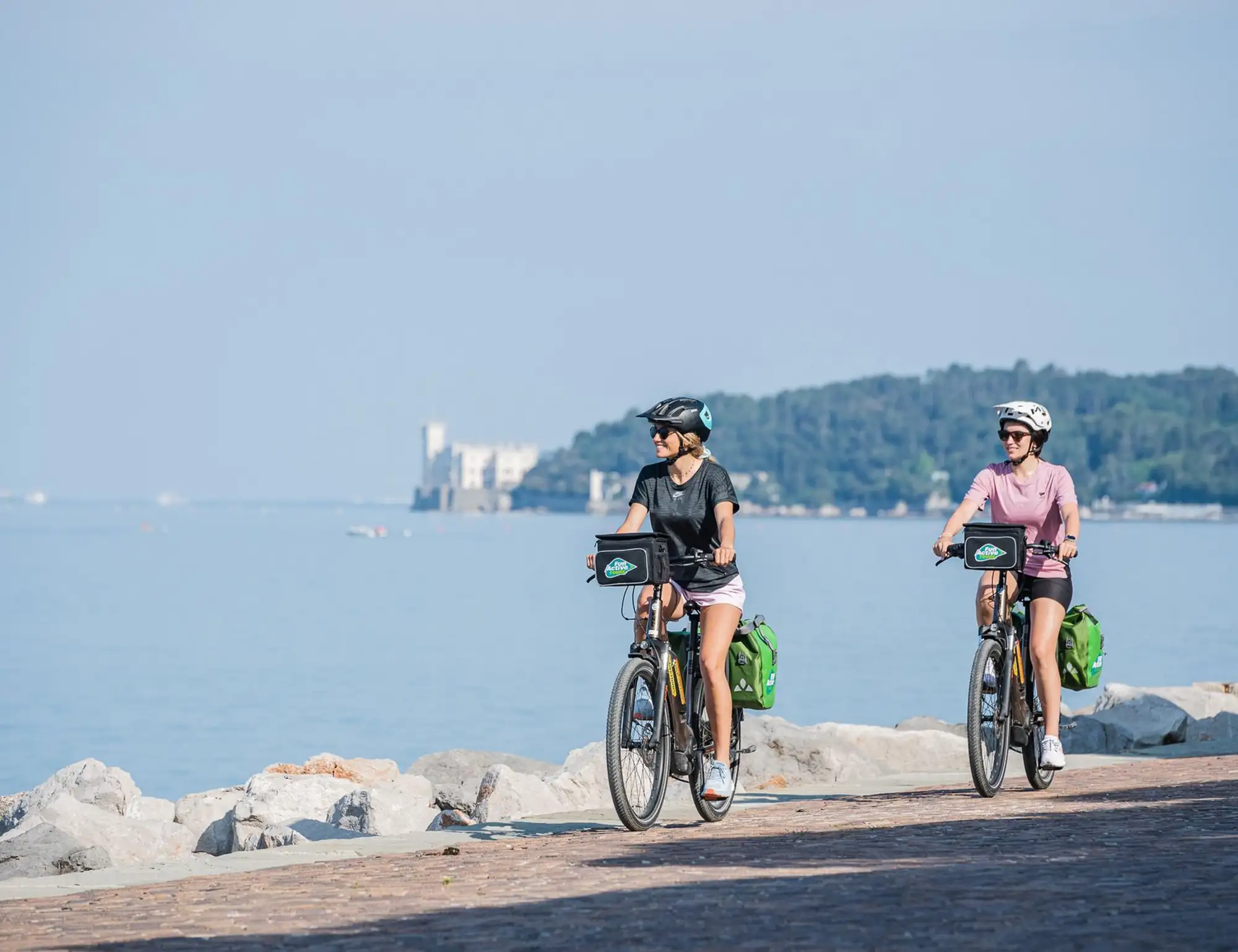
Popular
Self-Guided Trieste to Pula Bike Tour
8 daysfrom$1,795/person
